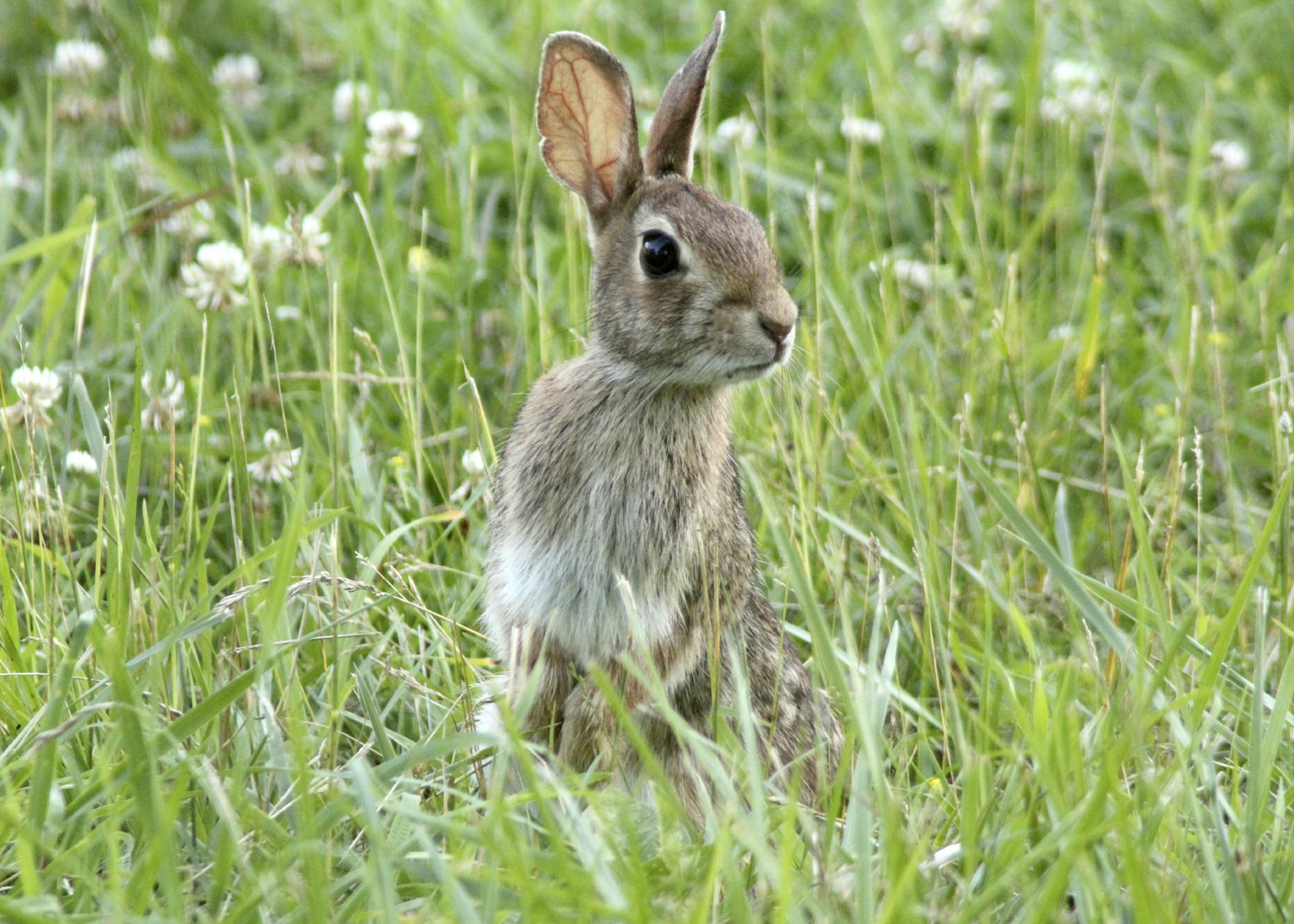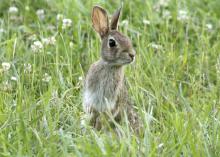Information Possibly Outdated
The information presented on this page was originally released on March 27, 2015. It may not be outdated, but please search our site for more current information. If you plan to quote or reference this information in a publication, please check with the Extension specialist or author before proceeding.
Rabbits signal spring and potential garden woes
STARKVILLE, Miss. -- With spring holidays just around the corner and garden season quickly approaching, there is no better time to discuss Mississippi’s resident rabbit, the eastern cottontail.
Many people think rabbits are a type of rodent because they have a tooth structure similar to that seen in squirrels, rats and mice. They also have a tendency to gnaw on plants, wood and other structures. However, rabbits are classified as lagomorphs because they have two pairs of upper and lower front teeth, and their food goes through a double-digestion process.
Cottontails’ preferred habitat is in areas with woody and dense vegetation. They seek shelter in holes and dense shrubs, as well as under buildings and piles of brush. They are common in urban, suburban and rural areas where abundant food and shelter are available. Cottontails found in rural areas spend their entire lives on a few acres of land.
In urban areas, rabbits may not venture far from a single backyard. Although rabbits can cause property damage, they fill an ecological niche as prey for other wildlife, including coyotes, fox, bobcats, eagles and hawks.
The breeding period for rabbits occurs from February through August. During this time, rabbits can bear between two and six kindles of kits with an average litter of three to five young. As an adaptation to their high death rates, cottontails can breed immediately after giving birth. Female cottontails form cup-shaped nests lined with fur under bushes or in tall grass where their young can remain hidden.
Lagomorphs in general are known for their inattentive parenting, visiting their young sometimes only once a day to nurse. However, female rabbits rarely abandon nests. If you suspect a nest has been abandoned, the best things to do are avoid disturbing it and keep domestic animals away. Chances are that the mother will return to care for the kits at a safe time.
It is also important to note that baby rabbits grow quickly and are able to leave the nest as early as 14 days after birth. They typically are weaned in less than one month and are completely independent of their mothers in eight weeks.
Although rabbits can cause damage any time of the year, spring is the most common time for homeowners to notice substantial losses. This is because rabbits prefer young, growing vegetation, such as tulips, garden vegetables, clover and turf grass. They also eat new shoots in crop fields and can cause losses for farmers.
In winter, rabbits gnaw through the bark of young trees and eat the cambium, or inner bark layer, which can significantly damage or even kill the tree. Homeowners will notice rabbit tracks and droppings near areas where damage occurs, as well as irregular gnawing on trees and roots. Unlike squirrels and deer, which leave jagged edges on stems when eating plants, rabbits will nip stems cleanly at a 45-degree angle.
In addition to damaging plants, rabbits can harbor diseases that affect human and pet health. Tularemia is the most significant disease associated with rabbits. Tularemia is caused by bacteria that can be contracted by humans through the bite of a rabbit, tick or flea, or by handling the carcass of an infected animal.
Tularemia symptoms in humans include fever, swollen lymph nodes and swelling around the bite, typically appearing within three to 14 days of exposure. Rarely is the infection fatal to humans, provided they receive antibiotics quickly. To reduce the risk of contracting tularemia, avoid direct contact with rabbits that are found dead or emaciated, as well as those that exhibit abnormal behavior, such as lethargy and lameness. Take precautions and wear latex or vinyl gloves when handling and butchering rabbits.
Like most mammals, rabbits can carry ticks infected with other diseases, such as Lyme disease. Since these diseases typically manifest themselves with flu-like symptoms, consider a tick-borne illness if anyone has symptoms within three weeks of being outdoors or handling rabbits.
Exclusion is the best and least expensive method for preventing rabbits from entering a garden or eating shrubbery. Poultry netting is inexpensive and particularly effective when installed as a 2-foot-tall fence around a garden or flowerbed. Netting also can be easily wrapped around the trunks of young trees.
In agricultural areas or at nurseries and tree farms, a double-strand electric fence is most effective when placed at heights of 5 and 10 inches above the ground. It is important to keep vegetation clear of the electric fence in order to maintain effectiveness. You can deter rabbits from nesting on property by securing wire mesh under sheds and decks.
By keeping grass mowed and removing brush piles and tall weeds, you can cut down on natural spots for rabbits to raise young. Homeowners could also discourage rabbits from damaging plants by planting less preferred species of vegetation and trees. Rabbits, like many herbivores, avoid plants with strong aromas, such as walnut and spruce. Plants with thorns or dense, hairy stems also deter them.
Rabbit hunting is a good source of recreation that can also help control rabbit populations. Visit the webpage for the Mississippi Department of Wildlife, Fisheries, and Parks for rabbit-hunting rules and regulations, and always obey firearm regulations in any area where you plan to hunt at http://www.mdwfp.com/.

Editor’s Note: Extension Outdoors is a column authored by several different experts in the Mississippi State University Extension Service.




